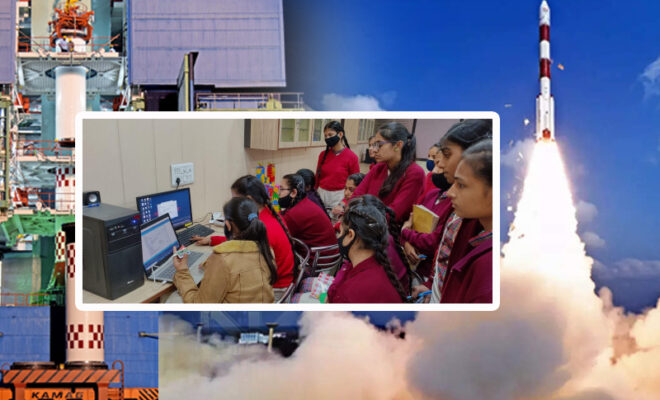ISRO’s Smallest Rocket To Launch Satellite Built By 750 School Girls

ISRO is going to launch its smallest commercial rocket, Small Satellite Launch Vehicle (SSLV), on 7th August. The SSLV will carry a satellite, AzaadiSAT.
Prime Minister Narendra Modi declared that during India’s 75th year of independence, the Tricolor would be flown in space, on August 15, 2018.
The Indian Space Research Organization (ISRO) will launch its smallest commercial rocket, the Small Satellite Launch Vehicle (SSLV), on August 7 in order to fulfill its commitment to unfold the flag in orbit.
The SSLV project is a part of the ‘Azadi Ka Amrit Mahotsav’ celebrations, to mark the 75th Independence year celebrations.
The prime minister had pledged to “undertake a human space mission on board ‘Gaganyaan,’ waving the national flag,” but the project has been postponed.
However, ISRO’s SSLV is an achievement in and of itself because it was designed to launch satellites and other payloads weighing under 500 kg into the planet’s lower orbit.
On August 7, at 9:18 a.m., the Satish Dhawan Space Center in Sriharikota will conduct the formal launch.
The SSLV will carry a co-passenger satellite dubbed “AzaadiSAT” that contains 75 payloads created by 750 young female students from 75 rural government schools in India to commemorate the nation’s “Azaadi Ka Amrit Mahotsav” celebrations.
This initiative was especially designed for the 75th anniversary of Independence Day to promote a scientific mindset and provide young females job options in space exploration.
With a height of 34 meters and a weight capacity of 500 kg, the SSLV is one of the greatest and most economical workhorses in the ISRO stable. It weighs around 120 tonnes.
The new satellite, according to ISRO Chairman S Somanath, is “a game changer” that will fuel India’s aspirations of entering into the valuable and expanding small satellite launch industry.
This cost-effective rocket has the quickest turnaround time and is built for mass production. It may be launched whenever it is needed.
With its successful launch, the SSLV will contribute to the expansion of partnerships between the space industry and other private Indian businesses, particularly in the worldwide small satellite market.
According to ISRO representatives speaking to media, the SSLV can launch tiny, micro, and nano satellites with a mass of 10 to 500 kg into a 500 km planar orbit.
The SSLV intends to create and develop a flexible, experimental satellite with an imaging payload. Important data will also be provided in the areas of forestry, hydrology, agriculture, soil, and coastal research.
The “AzaadiSAT” will conduct “femto experiments,” according to ISRO.
According to Rifath Sharook, Chief Technology Officer of Space Kidz India, their space mission was a “first of its kind.”
A senior official added that young students have created an 8-kg satellite with a payload that includes an accelerometer, temperature sensor, and radiation monitor, with an expected six-month life span.
An agreement for “AzaadiSAT” has been reached by IN-SPACeIND and SpaceKidz India.



